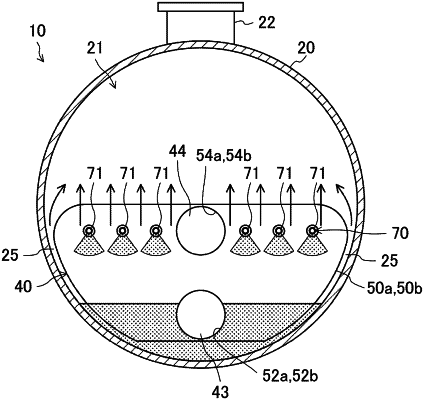| CPC F28D 9/005 (2013.01) [F25B 39/022 (2013.01); F28D 21/00 (2013.01); F28F 3/08 (2013.01); F25B 2339/0241 (2013.01); F28D 2021/0068 (2013.01)] | 9 Claims |

|
1. A shell-and-plate heat exchanger, comprising:
a shell forming an internal space; and
a plate stack, disposed in the internal space, comprising heat transfer plates that are stacked and joined together, wherein
the shell-and-plate heat exchanger is configured to allow a refrigerant that has flowed into the internal space to evaporate,
the plate stack forms:
refrigerant channels that communicate with the internal space and through which a refrigerant flows; and
heating medium channels that are blocked from the internal space and through which a heating medium flows, wherein
each of the refrigerant channels is adjacent to an associated one of the heating medium channels with one of the heat transfer plates interposed therebetween,
the shell-and-plate heat exchanger further comprises one or more supply structures that supply the refrigerant to the refrigerant channels such that the refrigerant flows downward,
the one or more supply structures are disposed inside outer peripheries of the heat transfer plates, and
each of the one or more supply structures comprises:
a refrigerant introduction channel that passes through the heat transfer plates and that is surrounded by the heating medium channels; and
supply holes that allow the refrigerant introduction channel to communicate with the refrigerant channels such that the refrigerant is supplied to the refrigerant channels, wherein
the refrigerant introduction channel is formed by joining the heat transfer plates together, and
the supply holes penetrate the heat transfer plates and open on front and back surfaces of the heat transfer plates.
|